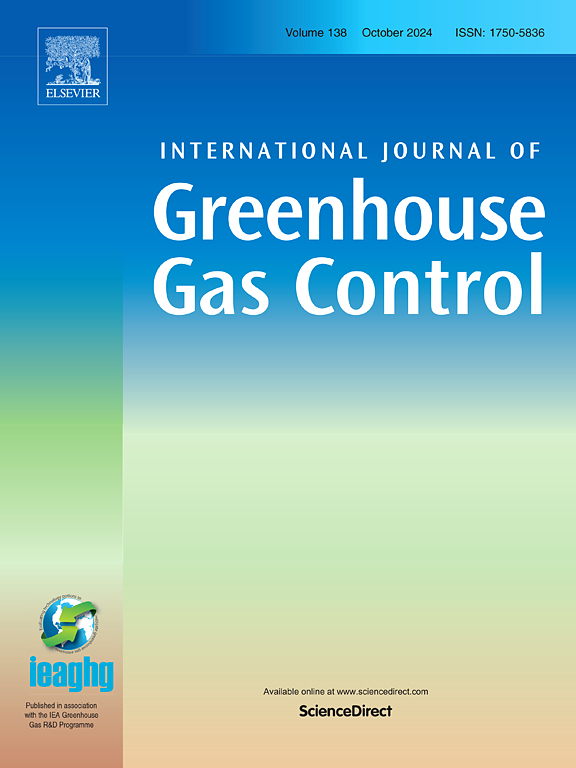Assessing the potential for CO2 sequestration of a saline aquifer in the Frio Formation, South Texas, USA
IF 5.2
3区 工程技术
Q2 ENERGY & FUELS
International Journal of Greenhouse Gas Control
Pub Date : 2025-08-05
DOI:10.1016/j.ijggc.2025.104441
引用次数: 0
Abstract
The Frio Formation onshore Texas, USA, represents a significant target for CO2 storage, and South Texas particularly has experienced an increased interest. This study evaluates a 100,000-acre area containing a ∼5000-foot-thick, sand-prone reservoir bounded by sealing normal faults. Reservoir connectivity, porosity, and permeability vary, with permeability potentially impacted by volcanic and carbonate content. The study addresses the need for reliable methods to evaluate storage potential in reservoirs with limited data, but located adjacent to legacy oil-gas activity. We provide a practical workflow to assess CO₂ storage in saline aquifers, producing defensible storage capacity estimates without requiring full reservoir modeling, while still accounting for reservoir heterogeneity and fault compartmentalization.
To define the site's structural configuration and stratigraphic framework, 3D and 2D seismic mapping were performed, as well as well-log correlation to subdivide the Frio stratigraphy into seven reservoir zones. Depositional facies analysis provided insights into sand distribution, lateral reservoir continuity, and sand presence in the syncline down-dip of the main rollover anticline. Petrophysical analysis characterized reservoir quality within the injection interval. Rock quality is emphasized due to its critical role in reservoir injectivity within the Frio section.
This comprehensive geological evaluation informed the CO2 pressure-based capacity calculations, estimating 460 million metric tons of storage potential within the Frio, in the area of interest. The study highlights the value of integrated methodologies and tailored approaches for assessing realistic CO2 storage capacities, offering practical solutions for South Texas storage and a comprehensive methodology for incorporating data from past oil-gas development to saline formations.
评估美国德克萨斯州南部弗里奥地层含盐含水层的二氧化碳封存潜力
美国德克萨斯州陆上的Frio地层是二氧化碳储存的重要目标,特别是德克萨斯州南部的兴趣越来越大。该研究评估了一个10万英亩的区域,该区域包含一个约5000英尺厚的易砂储层,储层由封闭的正断层包围。储层连通性、孔隙度和渗透率各不相同,渗透率可能受到火山和碳酸盐含量的影响。该研究解决了在数据有限且位于传统油气活动附近的储层中评估储层潜力的可靠方法的需求。我们提供了一个实用的工作流程来评估含盐含水层的CO 2储存量,在不需要完整的油藏建模的情况下,产生可靠的储存量估算,同时仍然考虑到油藏的非均质性和断层分区性。为了确定现场的构造形态和地层格架,进行了3D和2D地震测绘,并进行了测井对比,将Frio地层细分为7个储层带。沉积相分析揭示了主翻转背斜向斜下倾中的砂体分布、横向储层连续性和砂体存在。岩石物理分析对注入段内的储层质量进行了表征。由于岩石质量在Frio段的储层注入能力中起着关键作用,因此强调了岩石质量。这项综合地质评估为二氧化碳压力容量计算提供了依据,估计在感兴趣的地区,Frio的储存潜力为4.6亿吨。该研究强调了综合方法和定制方法在评估实际二氧化碳储存能力方面的价值,为南德克萨斯州的储存提供了实用的解决方案,并为将过去的油气开发数据整合到盐层提供了综合方法。
本文章由计算机程序翻译,如有差异,请以英文原文为准。
求助全文
约1分钟内获得全文
求助全文
来源期刊
CiteScore
9.20
自引率
10.30%
发文量
199
审稿时长
4.8 months
期刊介绍:
The International Journal of Greenhouse Gas Control is a peer reviewed journal focusing on scientific and engineering developments in greenhouse gas control through capture and storage at large stationary emitters in the power sector and in other major resource, manufacturing and production industries. The Journal covers all greenhouse gas emissions within the power and industrial sectors, and comprises both technical and non-technical related literature in one volume. Original research, review and comments papers are included.

 求助内容:
求助内容: 应助结果提醒方式:
应助结果提醒方式:


